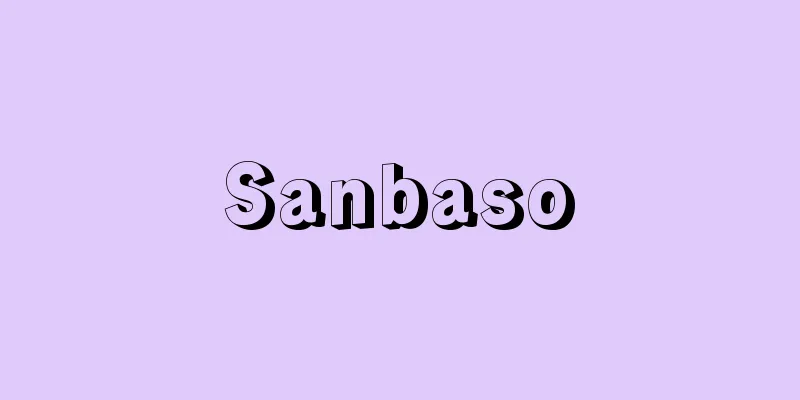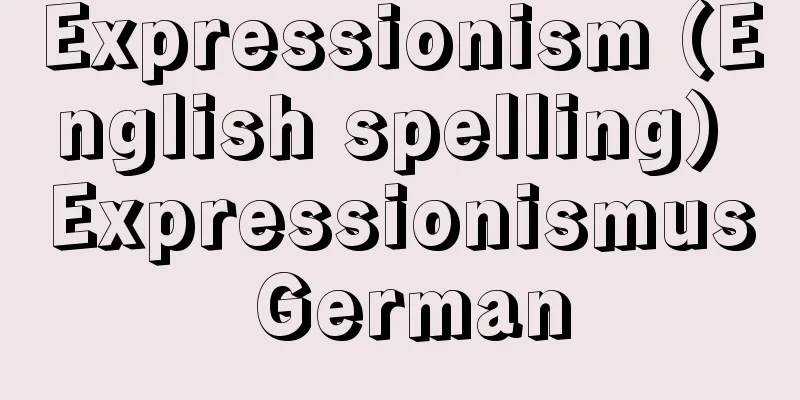Sanbaso

|
The name of a Kyogen piece. In the Okura school, it is written as "Sanbaso". In Noh, it is considered to be the counterpart of "Okina", and although Sanbaso is performed by Kyogen actors, "Sanbaso" and "Okina" are also called "Okina". In Kyogen, it is treated as a celebratory piece, just like the Noh "Okina". Its origins date back to the early "Hokke Gobu Kukansho" (Hokke five volumes, nine volumes) in 1126, where it is written as Chichi no Jo, Okina, and Sanban, with Sanban referring to Sanbaso. In this, Sanban is interpreted as referring to Maitreya, a Buddhist deity. The name Sanban seems to mean that it is the third piece to be performed, following Chichi no Jo and Okina. Zeami's "Fushikaden" records Sanbaso as Yotsugi no Okina, and later books refer to Sanbaso as Sumiyoshi Daimyojin. Some interpret Sanbaso as a god who brings peace and longevity to the world, and Sanbaso as a god of bountiful harvests. There is also the idea that Sanbaso is a "copycat" of Okina. Today's Kyogen "Sanbaso" is performed following the Noh "Okina." After the dances of Senzai and Okina finish and Okina leaves the stage, Sanbaso performs the "Momi no Dan" dance soberly, and then the "Suzu no Dan" dance. In the "Momi no Dan" dance, the performer begins with a tappai-style pose, followed by a light, nimble dance in the style of a dew sweeper. "Suzu no dan" is a sorcerous dance performed while wearing a black mask and swinging a bell. Some interpret the form of "Suzu no dan" as a representation of sowing seeds. It is said that the Sanbaso dance conveys the ancient art of Sarugaku, and that it originated from a sorcerer. It is said that "Morinodan" corresponds to Chitosemai and "Suzu no dan" corresponds to Okinamai. If so, then Sanbaso imitates an Okina, and has the impersonation that is the true art of Sarugaku at its root. The Okina that appears in the Flower Festival held in Toei Town, Toyone Village, and Shitara Town in Kitashitara County, Aichi Prefecture, is a Sanbaso, and he engages in humorous dialogue with the waki, which is probably one of the remains of an ancient form of Sanbaso. While the Okina mask is a smiling, dignified mask of good fortune, the Sanbaso mask has the same facial features as the Okina, but has a black face with a beard and a hair transplant under the nose and on the chin. Old Sanbaso masks have many variations, with the eyes shaped differently and the nose crooked, making them comical. They are probably representative of the old style of Sanbaso performance. [Kyoko Goto] Sanbaso performanceA type of Kabuki dance and traditional Japanese music. It is a Kabuki adaptation of the Noh play "Okina," with a focus on the elegant Sanbaso performed by a Kyogen actor, and is commonly referred to as "Sanbaso." The first is said to be "Rankyoku Sanbaso," danced by the first Nakamura Kanzaburo during the Kan'ei era (1624-1644). Famous works include "Tsutadashi Sanban," a later adaptation of this (Kiyomoto and Nagauta), as well as "Ayatsuri Sanban," "Sarashi Sanban," "Kuruwa Sanban," and "Hinazuru Sanban" in Nagauta, "Kodomo Sanban" in Tokiwazu, "Asahina Sanban" and "Shiki Sanbaso" in Kiyomoto, and "Ninin Sanban" in Gidayu. There are also pieces in the Itchu-bushi and Katou-bushi styles. In Edo Kabuki, there was a separate event called "Okinawatashi" during the Kabuki performances and New Year's, where the Tayumoto played the role of Okina, the Wakatayu played the role of Senzai, and the Zagashira actor played the role of Sanbaso, and prayed for the success of the play. A simplified version of this was the "Bandachi," which was performed by lower-ranking actors before the show began. The Nagauta piece "Kotobukishiki Sanbaso" (commonly known as "Shiki Sanban"), which conveys the ritualistic nature of this, is still performed today at theater opening ceremonies and other events. [Toshiaki Matsui] "A Study of the Origins of Nohgaku" by Nose Asatsugu (First Edition 1938/Reprint 1979, Iwanami Shoten)" "Honda Yasuji's "Okina and Others" (1958, Meizendo)" [Reference] | | | | | | |Source: Shogakukan Encyclopedia Nipponica About Encyclopedia Nipponica Information | Legend |
|
狂言の曲名。大蔵流では『三番三』と書く。能楽では『翁(おきな)』の対(つい)のように考えられ、三番叟を狂言方が勤めるが、『三番叟』を含めて『翁』ともいう。狂言では能の『翁』と同じように祝言曲として取り扱われている。起源は大治(だいじ)元年(1126)の『法華(ほっけ)五部九巻書』に出ていて古く、そのなかで、父尉(ちちのじょう)、翁、三番と記されており、三番というのが三番叟のことである。そこでは三番を弥勒(みろく)にあて仏教的解釈がなされている。三番という名称は父尉、翁に続いて3番目に演ずるという意味のようである。世阿弥(ぜあみ)の『風姿花伝(ふうしかでん)』には三番を世継(よつぎ)の翁と記してあり、後世の書物には、三番叟を住吉(すみよし)大明神にあてたりもしている。翁を天下太平、長寿をもたらす神と考え、三番叟を五穀豊穣(ほうじょう)の神とする解釈もある。また、翁の「もどき」という考え方もある。今日の狂言の『三番叟』は能の『翁』に続いて行う。千歳(せんざい)と翁の舞が終わり翁が退場すると、三番叟が素面で「揉(もみ)の段」を舞い、次に「鈴の段」を舞う。「揉の段」は最初に達拝(たっぱい)風の型をし、続いて露払い風の軽快な舞を舞う。「鈴の段」は黒尉面をつけて鈴を振りながら舞う呪術(じゅじゅつ)的な舞である。「鈴の段」の型は種下ろし、種播(ま)きを表現したものだという解釈もある。三番叟の舞は古い猿楽(さるがく)芸を伝えているともいい、呪師に発するともいう。「揉の段」は千歳舞に、「鈴の段」は翁舞にあたるというが、そうであれば三番叟は翁をまねたことになり、猿楽の本芸である物まね性を根本にもっていることになる。愛知県北設楽(きたしたら)郡東栄(とうえい)町、豊根(とよね)村、設楽町で行われている花祭に出てくる翁は三番叟で、ワキと滑稽(こっけい)な問答をするが、これは古い三番叟の一つの姿を残したものであろう。 翁面が笑いをたたえ、品格のある福相を示す面であるのに対し、三番叟は翁と同じ面相だが、鼻下、顎(あご)に植毛髭(ひげ)をつけ、顔は黒色で品がない。古い三番叟の面は変化が多く、両方の目の造形が違っていたり、鼻が曲がっていたりして滑稽にできている。三番叟芸の古様を示すものであろう。 [後藤 淑] 三番叟物歌舞伎(かぶき)舞踊、邦楽の一系統。能の『翁(おきな)』を、狂言方の勤める洒脱(しゃだつ)な三番叟中心に歌舞伎化したもので、一般に「~三番(叟)(さんば)」の通称でよばれる。寛永(かんえい)年間(1624~44)初世中村勘三郎が踊った『乱曲三番叟』が最初といわれ、これを後世に改作した『舌出し三番』(清元(きよもと)・長唄(ながうた))をはじめ、長唄の『操(あやつり)三番』『晒(さらし)三番』『廓(くるわ)三番』『雛鶴(ひなづる)三番』、常磐津(ときわず)の『子宝(こだから)三番』、清元の『朝比奈(あさひな)三番』『四季三葉草(しきさんばそう)』、義太夫(ぎだゆう)の『二人(ににん)三番』などが有名で、一中節(いっちゅうぶし)や河東節(かとうぶし)にも曲がある。別に江戸歌舞伎では顔見世興行や正月に、太夫(たゆう)元が翁、若太夫が千歳(せんざい)、座頭(ざがしら)役者が三番叟に扮(ふん)して芝居繁盛を祈る「翁渡し」の行事があり、これを簡略にしたものに下級俳優が開演前に演じる「番立(ばんだち)」があった。この儀式的な性格を伝える長唄の『寿式(ことぶきしき)三番叟』(俗に『式(しき)三番』)が現在でも劇場の開場式などで演じられる。 [松井俊諭] 『能勢朝次著『能楽源流考』(初版・1938/再版・1979・岩波書店)』▽『本田安次著『翁そのほか』(1958・明善堂)』 [参照項目] | | | | | | |出典 小学館 日本大百科全書(ニッポニカ)日本大百科全書(ニッポニカ)について 情報 | 凡例 |
Recommend
Fujiwara Ginjiro - Fujiwara Ginjiro
Year of death: March 17, 1960 Year of birth: 17th ...
Journalist
A Japanese movie released in 2019. Original story:...
Archips breviplicanus (English spelling) Archips breviplicanus
…[Hiroshi Inoue]. … *Some of the terminology that...
Talitridae
…When they come onto land, they move by jumping, ...
Itoyoshiginu - Itoyoshiginu
...Dupioni and Tsujii threads are used for wide w...
Theban legend
Part of Greek mythology. Set in the ancient city o...
Meister Francke
German late Gothic painter, c. 1380-1430. A painte...
Urayama Kofun - Urayama Kofun
<br /> An ancient tomb in Kamitsu-machi, Kur...
Ise-ryu
〘Noun〙① One of the schools of samurai ceremonies. ...
mimos
...The later classification of comedy of characte...
Act of government - Touchikoi (English spelling) Regierungsakt; acte de gouvernement
Even if legal judgment is possible, acts that are ...
International Airport - International Airport (English)
An airport where international flights depart and ...
Dentsu Inc.
Japan's largest advertising company. Nippon Ad...
German Peasants' War - German Peasants' War (English spelling) Bauernkrieg
A large-scale peasant uprising that spread mainly ...
Detonator - Lycan
A container filled with explosives to ignite or d...









